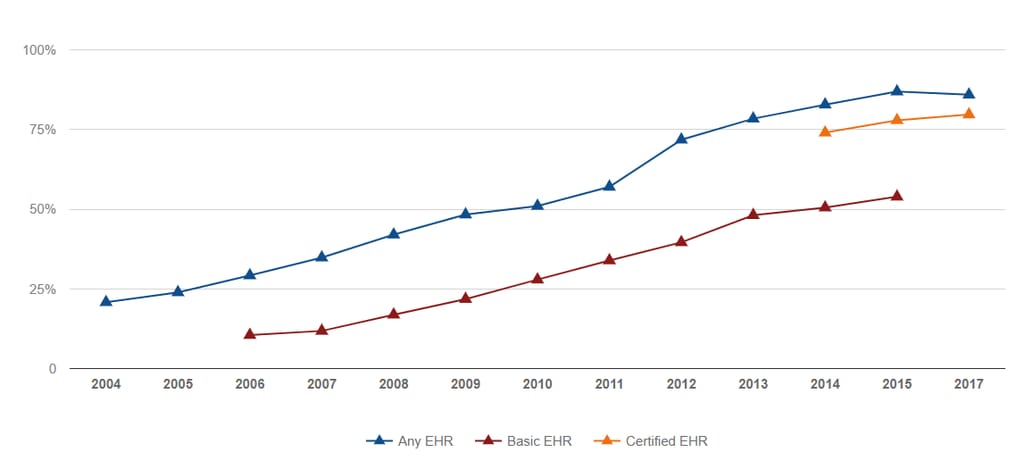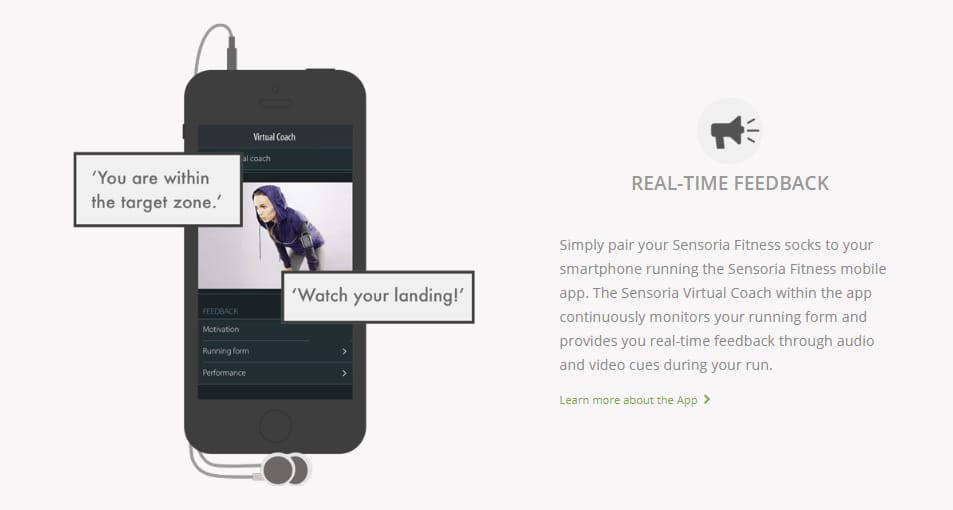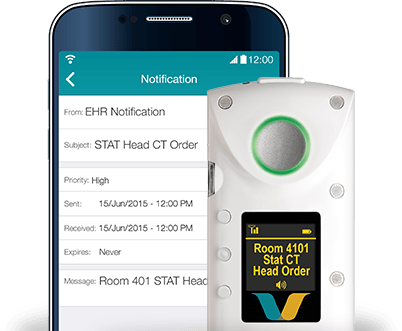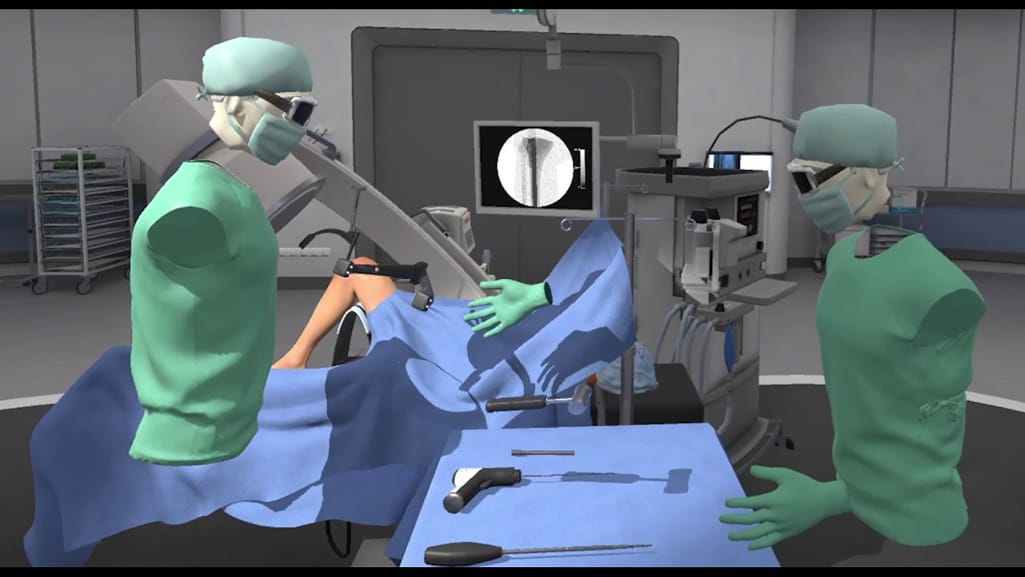“Some 40 percent of US healthcare consumers now use digital technologies in all aspects of their daily lives, or strive to do so. They expect this digital, convenient, customized, non-stop experience in healthcare. And they won’t hesitate to switch providers if they find a better service elsewhere.”
– Fit for tomorrow, Research paper by Accenture (2016).
Evolving customer expectations and needs are setting the bar high for business owners. Stagnation in the face of digital disruption means being at risk of losing customers and revenue. For smart, more forward-looking companies, that is all the impetus required for increasing investment in digital transformation.Client-oriented business domains such as retail, travel, and finance were among the first to adapt to the new market conditions, as we have already pointed out in previous articles from the Digital Transformation Stories series. Healthcare is no exception to this phenomenon. So, let’s look at the major digital trends transforming healthcare and how some leading brands are already capitalizing on them.
Digitization Strategies in Healthcare and Pharma
From medicine distribution to hospital management, healthcare has recently undergone some significant changes. The major drivers fueling innovation in healthcare are the cost and efficiency of services provided. In this regard, some of the most popular approaches to addressing these challenges are:Automated clinic management
Digitally-enabled hospitals prove to be more efficient and cost-effective due to streamlined, orderly internal processes managed by the programs. Plus, such hospitals present as being extremely customer-oriented as evidenced by simplified appointment process, accessibility of patient data (more on that later), reduced waiting times, and other pluses.EHR adoption
One of the major aspects of “paperless” hospitals is the adoption of electronic health records (EHRs). Instead of storing reams of paper records, test results, MRI scans, prescriptions, examination notes, and other info on the shelf at the doctor’s office, hospitals are actively digitizing this data, allowing for better accessibility and accuracy.Since 2008, adoption of EHRs by office-based physicians has more than doubled, from 42 in 2008 to 86 percent in 2017. That means about nine in 10 office-based physicians are managing clinical data in a digital form.

Interactive visualization on EHR adoption levels from early 2000s until 2017. Source: The Office of the National Coordinator for Health Information Technology
Personalized medicine
As a result of EHR adoption, many healthcare providers are currently focusing on highly personalized “precision” medicine. Based on deep insights sourced from the patient’s specifics, previous clinical records, genetic background or similar cases, healthcare providers can significantly increase treatment accuracy and thus improve outcomes.Telemedicine
Being able to connect with the doctors despite distance or busy schedules is another benefit of digital healthcare. From connecting with a specialist to get a professional consultation from the comfort of your couch to getting complex surgery performed by a robot remotely operated by a famous doctor from across the world, telemedicine has huge potential to transform healthcare.Remote patient care is growing popular very fast. According to the American Well telemedicine company, only 5 percent of physicians used telemedicine in 2015. Three years later, 22 percent of them did. That’s a 340 percent adoption increase. Some of the reasons people choose telemedicine are lower costs and the ability to schedule an urgent appointment.
M-Health and wearables
Just like any other industry, healthcare was compelled to respond to the massive adoption of mobile technologies by consumers. Gartner predicts that in 2020 consumers will spend 27 percent more on wearables than in 2019. They will spend most on smartwatches and smart clothes.
Data analytics and security
There are many use cases for data science in healthcare. The data sourced from EHRs and patient profiles has the potential to significantly improve diagnostic accuracy, leading to better medical decisions, treatment outcomes, and contributing to breakthrough research. However, healthcare providers need to take good care of patient personal data. During 2019, more healthcare records were stolen than there were from 2009 to 2014. In total, data breaches of 500 and more records happened 510 times. Thus, innovative security technologies are in high demand in healthcare.
Documented healthcare data breaches from 2009 until 2019. Source: HIPAA Journal
As we can clearly see, digital transformation impacts both the customer and healthcare’s operational aspects. While patient care becomes more proactive, convenient, and accurate, hospitals are becoming more efficient, adding even more value to the healthcare providers. To see the listed trends in action, let’s consider several examples of the healthcare companies with winning digitization strategies.Mayo Clinic: Partnering with Google to store medical data and drive clinical research
Mayo Clinic is a medical center with campuses in five US states, including its headquarters in Rochester, Minnesota. It serves over 1 million people a year, in addition to conducting research and providing education programs.In September 2019, Mayo Clinic and Google announced a 10-year partnership. "Data-driven medical innovation is growing exponentially, and our partnership with Google will help us lead the digital transformation in health care," said Dr. Gianrico Farrugia, president and CEO at Mayo Clinic.
The agreement implies several projects in itself. The hospital system will build its data platform on Google Cloud to store its medical, genetic, and financial data. Google Cloud provides services like computing, data analytics, storage, AI, and machine learning (ML). The institution stresses it alone will have access to patient data, and Google will be forbidden to combine Mayo data with any other data.
According to the agreement, Mayo Clinic physician leadership also planned to develop ML models for complex diseases jointly with Google specialists. The tech giant will open an office near the Rochester campus to let its engineers work side by side with the healthcare provider’s physicians, researchers, IT specialists, and data scientists. If you want to know how AI and machine learning can aid disease detection and screening, check this article on deep learning in medical diagnosis we published recently.
Pfizer Inc.: Driving the ePharma Industry Forward
Another global pharmaceutical corporation, Pfizer Inc., has a solid track record of successful digital initiatives. As a part of its digital transformation strategy, the company modernized most of its 35 enterprise products, migrating them to the cloud. By improving their efficiency, the company has been able to reduce operating costs for both the IT department and the whole organization by about $1.5 billion. Their Center of Excellence of analytics is an award-winning initiative, using numerous pools of clinical data to create more efficient medicine.Back in 2011, the company made a big bet on the Internet of Things developing an experimental Parkinson’s treatment. Collaborating with the IBM Watson team, the company was developing a sensor-enabled remote patient monitoring system that would make it possible to track patient health and activity in their day-to-day life outside of the clinical trial labs.
The clinical trials, scheduled for 2019, were cancelled due to low enrollment. Despite that, the project allowed Pfizer to use this experience in their future undertakings and help other companies learn from their experience. Plus, remote/virtual trials remain a promising opportunity in the increasingly digitalized healthcare and pharma industry.
As many other companies, Pfizer is also involved in a number of outside research initiatives. For example, Project Catalyst, initiated by AARP in cooperation with Pfizer, UnitedHealthcare, and Georgia Tech, researches how 50-plus consumers use and evaluate the design and functionality of new health-tech products. In one of the latest studies, family caregivers were testing personal emergency response systems (PERS), home care aide hiring, and care coordination platforms for up to six weeks. You can read about brief findings here.
Halifax Health: Investing in Reliability and Efficiency
Halifax Health is one of the leading healthcare providers in Florida, operating 20+ physical locations and serving over 120,000 emergency room patients annually. Founded in 1928, the organization was crippled with outdated IT infrastructure and its limited capacity. Thus, the company decided to start its digital transformation with a complete legacy systems modernization. As a result, Halifax Health migrated 95 percent of its 200 physical servers to the cloud. The company was operating over 700 virtual servers as for 2017.As Tom Stafford, Vice President and CIO at Halifax Health, has stated, “The most important thing we did in the past five years is standardize everything so we have consistency throughout the organization. It allows us to support a large base of users with fewer resources. So even though we have 700 servers, we only need two team members to support them, because every server is exactly the same.”
While server patching used to take up to 40 hours of downtime, this can be now performed in less than 14 hours. Moreover, there was not a single outage of the campus network over the last 3 years due to the upgrade. Thus, the company gained competitive benefits of uninterrupted patient service, increased internal flexibility, and efficiency.
Another major innovation at Halifax Health is aimed at increasing speed and efficiency of communication between physician and patient as well as internal processes. The company invested in providing its employees with Vocera Badges, voice-controlled wearable devices allowing for hands-free communication. These devices serve for voice communication as well as HIPAA-compliant and secure text messaging.

A badge for hospital communication.Source: Vocera.com
After adopting the technology within the emergency department staff, where timely communication is critical, the company saw a significant increase in employee efficiency and satisfaction. Communication processes that usually took 30-45 minutes are completed in seconds. The adoption was also quite high: Within 6 months of implementation, more than 16,000 text conversations and 18,000 alerts were transmitted to the badges.The healthcare provider has also improved clinical documentation workflows for physicians, the clinical documentation improvement (CDI) team, and clinical coders. Halifax Health used three AI-powered solutions by Nuance to complement its EHR system. Solutions are aimed at the main problem: the quality of patient notes. One of the solutions prioritizes cases with mistakes or insufficient details for the CDI team that’s responsible for the records’ consistency. Another tool analyzes records as they are created, so doctors can fix their documentation at the point of care. The third solution uses speech recognition and transforms patient stories that clinicians made with their voice into text.
The Dragon Medical One tool for capturing voice information about patients. Source: Nuance
As a result, Halifax Health could reduce the number of severity queries by 63 percent and increase its case coverage by 20 percent.Partners Healthcare: Betting Big on EHR
A large Boston-based hospital network, Partners Healthcare, has invested $1.2 billion in its EHR project. The implementation costs doubled from an initially estimated $600 million.Yet, the company still views this as a reasonable and strategically important investment. According to Keith Jennings, CIO at one of the hospitals in the network, “a project like this, this is not an IT implementation, this is a business transformation.”
The new system was expected to host millions of patient records within the network of 10 hospitals and 6,000 doctors. When done right, EHR adoption greatly impacts employees’ routine. Replacing the patchwork of dozens of systems and tools used by different hospitals, it allows for easy data sharing within the network. This means, a patient can consult with a doctor at any of the hospitals or practices confident that his/her information won’t get lost. It will be saved to the general database, easily accessed by any doctor within the Partners’ network . This has the potential to help doctors avoid medical errors.
The EHR system was deployed phase by phase, starting in May 2015 and finishing in 2017.
In 2018, Partners made EHR data publicly available for patients, so they can evaluate the provider's performance rather than claims data. "EHR data is a better reflection of clinical care...There are a lot of limitations to claims data. The data can be years old … and they lack clinical nuance," noted Dr. Tom Sequist, chief quality and safety officer at Partners.
To give patients access to data, the provider developed a tool that classifies information by various conditions like depression, blood pressure control, stroke care, diabetes care, or cancer screening.
Newcastle Hospital: Simulation Center uses VR for surgeon training
How do surgeons train to do procedures? The use of live animals, happily for animal rights activists and all people concerned, gradually declines. For example, the last medical schools using it in the US and Canada ended this practice in 2016.Other low-tech options are banana peels, oranges, or grapes on which surgeons practice cutting and stitching skin. Or chicken feet: “As recently as five to 10 years ago, we bought chicken feet from grocers in Chinatown markets and had our residents practice techniques of tendon repair by suturing chicken flexor tendons,” said Dr. Donald Bae, an orthopedic surgeon at Boston Children’s Hospital.
More advanced common ways to practice skills are surgery simulators – mannequins, screen-based simulators that can be combined with mannequins to add a haptic experience. Here is when virtual reality steps in to innovate surgical training. There are numerous VR and AR vendors on the market, such as ImmersiveTouch, Osso VR, Proprio, or FundamentalVr, that cooperate with hospitals across the US and Europe.
One of those institutions, Newcastle Hospital’s Simulation Centre (UK), uses the Osso VR interactive platform to help surgeons sharpen their skills to perform complicated operations. The hospital’s director of robotic surgery Naeem Soomro said they bought the system to help orthopedic trainees practice doing minor procedures in knee surgery. "What we hope is that once they can do that, they can move on to doing operations on cadavers and in real life much more quickly," he added.
The platform mimics the realistic environment of an operating theatre and allows for evaluating a trainee’s skills with a score that’s based on how precisely and effectively they complete a series of steps during a specific procedure.
Besides, surgeons can train together in a common environment even if they are in different locations.


Showcase of how two surgeons can train together in one VR space. Source: Osso VR
Newcastle Surgical Training Centre holds nearly 300 surgical courses every year. VR training might become an important component of surgical training in the future, thinks Dr. Soomo.Peninsula Regional Medical Center: AI-based tool for drug database search by IBM eases the workflow for pharmacists
For a single drug prescription or dispense, a pharmacist does full research evaluating many factors: dosing information, compatibility with current drugs a patient takes, chronic conditions, or administration preferences. Now imagine a specialist must define the optimal drug for an emergency department patient, and the faster they do so, the better. This involves querying a drug database.IBM Watson Health Perspectives published a story about AI capabilities to enhance pharmacists’ workflows. Dennis Killian, Director of Pharmacy at Peninsula Regional Medical Center in Salisbury, Maryland, participated in the article.
The healthcare specialist first told how he searches for drug data to prescribe the right medication. “A typical example of Killian’s drug search process starts when a clinician calls to ask about a dosage adjustment for a particular medicine based on that patient’s kidney function. He’ll access his drug database, enter the specific drug, then toggle through options to identify dosage guidelines based on patient age, weight, and other factors to provide evidence-based recommendations.”
In 2018, it became a bit easier for Killian and his colleagues to do their job. They were testing an AI-based tool integrated into the facility’s drug information database. The solution allowed them to use queries in natural language instead of filtering out data with keywords. Pharmacists could just write questions like What’s the adult dose of rivaroxaban for DVT? Are there renal dosing adjustments? Can I give it with food? What should I monitor?
“The answers appear instantly, without our team needing to navigate and toggle through menus,” explained Dennis. That way, the hospital employees no longer had to spend time on mastering how to use legacy databases.
The system learns from data, meaning that query results become more precise over time: “Over the course of our first 15 weeks testing the technology, we saw its level of understanding advance considerably,” said the pharmacist.
The solution became available for trial on August 29, 2018. Over 50 clinicians in six countries were testing it for several months.
Competing in the Age of Digital Healthcare: First-Hand Experience
While the above-listed cases represent mostly large, enterprise-level organizations, there is ample opportunity for small businesses to join the race. As an example, one of our clients, a practicing Canadian physician, turned to AltexSoft to implement a digital solution to efficiently run his practice.A custom clinic management tool was needed that was capable of setting appointments, storing patients’ records, and creating invoices. The solution was required to work with different user types and dissimilar access permissions, and still be secure enough to handle personal health data.
The AltexSoft team developed the required solution enabling the client to move all his internal operations to the cloud, providing an easy, efficient way to run the practice. When the owner of the newly developed solution decided to completely change the business model for which the solution was created, AltexSoft deftly expanded the product. And now, the custom clinic management tool has been transformed into a successful subscription-based SaaS product.
After several major hospital chains adopted the product, our team has further customized it by adding multi-user features and admin permissions. And before you knew it, our client did not just streamline his own internal operations, but opened new, vibrant revenue streams.
If you are planning to enhance your digital footprint or adapt your business model to modern market demands, finding a reliable and knowledgeable technology consulting partner is a must. This will not only increase your chances for success but also give you a competitive benefit of faster time to market and unlimited future growth.
To learn more about digital transformation success stories across different industries, see other articles from the series.
- Digital Transformation in Retail: How Starbucks, IKEA, Walmart, and Sephora Revolutionize Industry
- Digital Transformation Stories: How JetBlue and Marriott Advance Travel Experience
- Digital Transformation Stories: How MasterCard® and Capital One® Have Joined the Fintech Wave
- Digital Transformation Stories: How UPS, Amazon, JD.com, Delta and Maersk Change Transportation and Logistics Industry
- Digital Transformation in Supply Chain Management: How Levi Strauss, PepsiCo, and GSF Boost Operations

